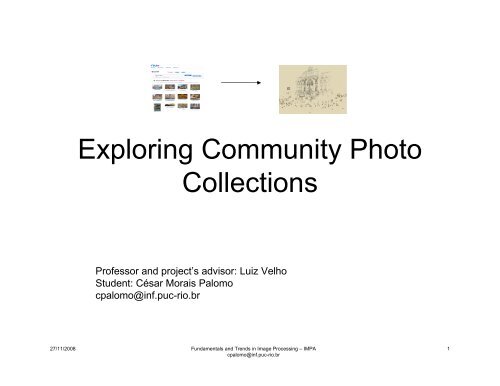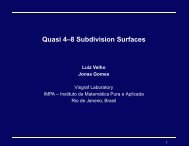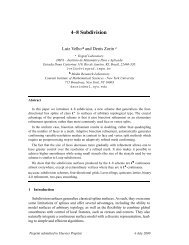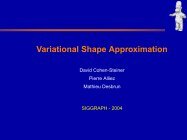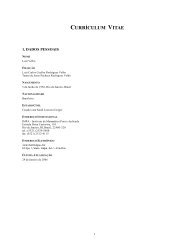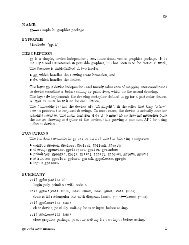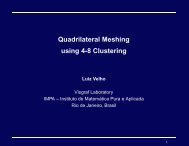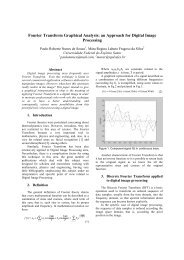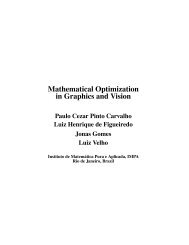pdf file, 3 MB - Luiz Velho - IMPA
pdf file, 3 MB - Luiz Velho - IMPA
pdf file, 3 MB - Luiz Velho - IMPA
You also want an ePaper? Increase the reach of your titles
YUMPU automatically turns print PDFs into web optimized ePapers that Google loves.
Exploring Community Photo<br />
Collections<br />
Professor and project’s advisor: <strong>Luiz</strong> <strong>Velho</strong><br />
Student: César Morais Palomo<br />
cpalomo@inf.puc-rio.br<br />
27/11/2008 Fundamentals and Trends in Image Processing – <strong>IMPA</strong><br />
cpalomo@inf.puc-rio.br<br />
1
Motivation<br />
Fact (= opportunity): more than 10 million members of the<br />
photo-sharing Web site Flickr snap pictures of their<br />
surroundings and then post those photos on the Internet<br />
Do the opposite: download photos from Flickr and use<br />
them to recreate the original scenes<br />
Google Images and Flickr: powerful new type of image<br />
dataset for computer vision and computer graphics<br />
research<br />
27/11/2008 Fundamentals and Trends in Image Processing – <strong>IMPA</strong><br />
cpalomo@inf.puc-rio.br<br />
2
Characteristics of CPC’s<br />
Opportunities Challenges<br />
Different<br />
viewpoints<br />
Image-based<br />
rendering<br />
Different<br />
photographers<br />
3D<br />
reconstruction<br />
CPC’s<br />
Extreme<br />
variability<br />
Querying<br />
Varying lighting<br />
and appearance<br />
Visualization<br />
Objective: find algorithms that operate robustly and successfully<br />
on such image sets to solve problems in computer vision and<br />
computer graphics<br />
27/11/2008 Fundamentals and Trends in Image Processing – <strong>IMPA</strong><br />
cpalomo@inf.puc-rio.br<br />
3
Related work<br />
2006 Noah Snavely et al’s Photo Tourism<br />
– Developed for browsing large collections of photographs in 3D.<br />
It automatically computes each photo’s viewpoint and a<br />
sparse 3D model of the scene. Photo explorer for moving<br />
about the 3D scene, through the photos.<br />
2008 Noah Snavely et al’s Finding Paths Through World Photos<br />
– Presents further advances in the navigation control. Exposes<br />
details of how to discover a set of paths for traversing<br />
interesting regions and viewpoints of a scene, and how to<br />
take advantage of them to improve the user control during<br />
image-based rendering.<br />
2007 Goesele et al’s Multi-View Stereo for Community Photo<br />
Collections<br />
– Try to reconstruct the 3D geometry of a scene from photo<br />
collections. Remarkable results.<br />
27/11/2008 Fundamentals and Trends in Image Processing – <strong>IMPA</strong><br />
cpalomo@inf.puc-rio.br<br />
4
Proposal<br />
Input photos<br />
Scene<br />
Reconstruction<br />
Relative camera<br />
positions and<br />
orientations<br />
Point cloud<br />
• Develop a full functioning structure from motion (SfM)<br />
framework to be used for CPC’s, in a similar fashion to what<br />
has been done in Photo Tourism work.<br />
• Follow the steps shown in the cited related work to validate<br />
the effectiveness of the SfM method.<br />
• Make some minor modifications to the general proposed in<br />
order to try to improve performance.<br />
27/11/2008 Fundamentals and Trends in Image Processing – <strong>IMPA</strong><br />
cpalomo@inf.puc-rio.br<br />
5
Method<br />
1. Features/keypoint detection in the input images using SIFT<br />
2. Features matching for each pair of images<br />
3. Fundamental matrix estimation using the eight-point<br />
algorithm, using RANSAC<br />
4. Removal of matches that are outliers to the estimated<br />
fundamental matrix<br />
5. Structure from motion step to estimate the parameters of<br />
each pair of cameras, in a bundle adjustment process<br />
27/11/2008 Fundamentals and Trends in Image Processing – <strong>IMPA</strong><br />
cpalomo@inf.puc-rio.br<br />
6
Method – Step 1<br />
1. Features/keypoint detection in the input images using SIFT<br />
2. Features matching for each pair of images<br />
3. Fundamental matrix estimation using the eight-point<br />
algorithm, using RANSAC<br />
4. Removal of matches that are outliers to the estimated<br />
fundamental matrix<br />
5. Structure from motion step to estimate the parameters of<br />
each pair of cameras, in a bundle adjustment process<br />
27/11/2008 Fundamentals and Trends in Image Processing – <strong>IMPA</strong><br />
cpalomo@inf.puc-rio.br<br />
7
Features detection<br />
• Detect keypoints for each image using Lowe’s SIFT<br />
• To try to speed up this step, used Wu’ SiftGPU<br />
– Implementation of SIFT for GPU<br />
– GPU shaders used in Gaussian pyramid construction, DoG<br />
keypoint detection and descriptor generation<br />
– Processes pixels and features paralelly in GPU and builds<br />
compact feature list by using GPU reduction: per-pixel<br />
processing changed to per-feature processing – reduces<br />
readback time<br />
27/11/2008 Fundamentals and Trends in Image Processing – <strong>IMPA</strong><br />
cpalomo@inf.puc-rio.br<br />
8
Method – Step 2<br />
1. Features/keypoint detection in the input images using SIFT<br />
2. Features matching for each pair of images<br />
3. Fundamental matrix estimation using the eight-point<br />
algorithm, using RANSAC<br />
4. Removal of matches that are outliers to the estimated<br />
fundamental matrix<br />
5. Structure from motion step to estimate the parameters of<br />
each pair of cameras, in a bundle adjustment process<br />
27/11/2008 Fundamentals and Trends in Image Processing – <strong>IMPA</strong><br />
cpalomo@inf.puc-rio.br<br />
9
Features matching<br />
• SIFT descriptor: 128-dimension vector of integers<br />
• Matching: try to identify corresponding features for each<br />
pair of images - relationship among photos<br />
X =<br />
27/11/2008 Fundamentals and Trends in Image Processing – <strong>IMPA</strong><br />
cpalomo@inf.puc-rio.br<br />
10
Robust features matching<br />
• Naive approach for matching: brute-force computation of<br />
all distances for complete list of features for each pair of<br />
images<br />
• Better try: use Mount’s approximate nearest neighbors<br />
library to speed up search<br />
– Data structures and algorithms for exact and approximate<br />
nearest neighbor searching in arbitrarily high dimensions<br />
– Based on kd-trees and box-decomposition trees<br />
– Distances measured using any class of distance<br />
functions called Minkowski metrics<br />
27/11/2008 Fundamentals and Trends in Image Processing – <strong>IMPA</strong><br />
cpalomo@inf.puc-rio.br<br />
11
Method – Step 3<br />
1. Features/keypoint detection in the input images using SIFT<br />
2. Features matching for each pair of images<br />
3. Fundamental matrix estimation using the eight-point<br />
algorithm, using RANSAC<br />
4. Removal of matches that are outliers to the estimated<br />
fundamental matrix<br />
5. Structure from motion step to estimate the parameters of<br />
each pair of cameras, in a bundle adjustment process<br />
27/11/2008 Fundamentals and Trends in Image Processing – <strong>IMPA</strong><br />
cpalomo@inf.puc-rio.br<br />
12
Fundamental matrix<br />
• Computer vision: 3x3 matrix of rank 2 which relates corresponding<br />
points in stereo images: allows for detection of wrong<br />
correspondences<br />
• Epipolar geometry: with corresponding points m and m’ in a stereo<br />
image pair, Fm describes the epipolar line on which m’ on the other<br />
image should lie:<br />
m' T Fm = 0 m = [ x y 1] T<br />
m'=<br />
[ x'<br />
y'<br />
1] T<br />
• Being of rank 2 and determined only<br />
up to scale, the F-matrix can be estimated<br />
given at least seven point correspondences<br />
27/11/2008 Fundamentals and Trends in Image Processing – <strong>IMPA</strong><br />
cpalomo@inf.puc-rio.br<br />
13
F-matrix estimation: the 8-point algorithm<br />
• Rewriting the equation:<br />
• F-matrix: determined up to a scale factor<br />
– 8 equations are required to obtain a unique solution<br />
[xx’ yx’ x’ xy’ yy’ y’ x y 1] f = 0<br />
f = [F11<br />
F12<br />
F13<br />
F21<br />
F22<br />
F23<br />
F31<br />
F32<br />
F33]<br />
• By stacking eight of these equations (8 point correspondences) in matrix A:<br />
Af<br />
= 0<br />
• Least-squares: perform SVD on A to get the eigenvector associated with<br />
the smallest singular value, i.e., the Null Space for A.<br />
[U, S, V] = svd(A)<br />
• Select the column of V that is associated with the least (or zero) singular<br />
value in S: the last column is our F_cand<br />
• Enforce constraint that fundamental matrix has rank 2 by performing a SVD<br />
on F_cand and then reconstructing with the two largest singular values<br />
27/11/2008 Fundamentals and Trends in Image Processing – <strong>IMPA</strong><br />
cpalomo@inf.puc-rio.br<br />
14
F-matrix estimation: normalization<br />
• F is often ill-conditioned: small variations in the data points (x,y<br />
coordinates) selected will completely mess up the calculation for F<br />
– i.e, magnitude of elements in A matters!<br />
• How to solve or minimize this problem? Perform data normalization:<br />
– Translate mean location to origin<br />
– Scale so that average x and y distance to the origin is 1<br />
8<br />
∑<br />
i= 1<br />
x i<br />
= 0<br />
8<br />
8<br />
∑<br />
i= 1<br />
y i<br />
= 0<br />
8<br />
8<br />
∑<br />
i= 1<br />
( x<br />
i<br />
− x)<br />
2<br />
+ ( y<br />
8 2<br />
i<br />
− y)<br />
2<br />
= 1<br />
x =<br />
8<br />
∑<br />
i=<br />
1<br />
xi<br />
n<br />
y<br />
=<br />
8<br />
∑<br />
i=<br />
1<br />
yi<br />
n<br />
d<br />
=<br />
8<br />
∑<br />
i=<br />
1<br />
( x<br />
i<br />
− x)<br />
2<br />
8<br />
+ ( y<br />
2<br />
i<br />
−<br />
y)<br />
2<br />
⎛1/<br />
d<br />
⎜<br />
T = ⎜ 0<br />
⎜<br />
⎝<br />
0<br />
0<br />
1/ d<br />
0<br />
− x / d ⎞<br />
⎟<br />
− y / d ⎟<br />
⎟<br />
1<br />
⎠<br />
27/11/2008 Fundamentals and Trends in Image Processing – <strong>IMPA</strong><br />
cpalomo@inf.puc-rio.br<br />
15
F-matrix estimation: normalized 8-point<br />
algorithm<br />
• Calculate normalization matrices for chosen points<br />
• Use normalized points in the described 8-point algorithm<br />
• Obtain the fundamental matrix for the original untransformed data<br />
by taking:<br />
F = T<br />
T<br />
l<br />
F' T<br />
r<br />
27/11/2008 Fundamentals and Trends in Image Processing – <strong>IMPA</strong><br />
cpalomo@inf.puc-rio.br<br />
16
RANSAC - RANdom SAmple Consensus<br />
• Iterative method to estimate parameters of a mathematical model<br />
from a set of observed data which contains outliers<br />
• A non-deterministic algorithm in the sense that it produces a<br />
reasonable result only with a certain probability, with this probability<br />
increasing as more iterations are allowed<br />
• Very interesting for robust estimation of a model when data<br />
contains outliers and noise<br />
27/11/2008 Fundamentals and Trends in Image Processing – <strong>IMPA</strong><br />
cpalomo@inf.puc-rio.br<br />
17
RANSAC general method<br />
Repeat for a fixed number of iterations:<br />
maybe_inliers := n randomly selected values from data<br />
maybe_model := model parameters fitted to maybe_inliers<br />
consensus_set := maybe_inliers<br />
for every point in data not in maybe_inliers<br />
if point fits maybe_model with an error smaller than t<br />
add point to consensus_set<br />
if number of elements in consensus_set is > d (good model, now test how good it is)<br />
better_model := model parameters fitted to all points in consensus_set<br />
this_error := a measure of how well better_model fits these points<br />
if this_error < best_error (best model found so far)<br />
best_model := better_model<br />
best_consensus_set := consensus_set<br />
best_error := this_error<br />
27/11/2008 Fundamentals and Trends in Image Processing – <strong>IMPA</strong><br />
cpalomo@inf.puc-rio.br<br />
18
RANSAC for F-matrix estimation<br />
Repeat for a fixed number of iterations:<br />
maybe_inliers := 8 randomly selected matches<br />
F_cand := normalized_8-point_algorithm using maybe_inliers<br />
this_error = evaluate F_cand against all data<br />
if this_error < best_error (best F found so far)<br />
F_best := F_cand<br />
best_error := this_error<br />
After the fixed number of iterations, find inliers and outliers:<br />
consensus_set := inliers for F_best, using distance to epipolar line as the err measure<br />
outliers_set := all matches – consensus_set<br />
How to evaluate F_cand:<br />
error = 0<br />
for each match (p1,p2) in all data<br />
error += findDistanceToEpipolarLine(p1, p2, F_cand) +<br />
findDistanceToEpipolarLine(p2, p1, transpose(F_cand))<br />
27/11/2008 Fundamentals and Trends in Image Processing – <strong>IMPA</strong><br />
cpalomo@inf.puc-rio.br<br />
19
Method – Step 4<br />
1. Features/keypoint detection in the input images using SIFT<br />
2. Features matching for each pair of images<br />
3. Fundamental matrix estimation using the eight-point<br />
algorithm, using RANSAC<br />
4. Removal of matches that are outliers to the estimated<br />
fundamental matrix<br />
5. Structure from motion step to estimate the parameters of<br />
each pair of cameras, in a bundle adjustment process<br />
27/11/2008 Fundamentals and Trends in Image Processing – <strong>IMPA</strong><br />
cpalomo@inf.puc-rio.br<br />
20
Outliers removal by RANSAC<br />
• RANSAC not only robustly fits a good F-matrix, but also remove outliers<br />
from consideration<br />
All matches Inliers Outliers<br />
+<br />
27/11/2008 Fundamentals and Trends in Image Processing – <strong>IMPA</strong><br />
cpalomo@inf.puc-rio.br<br />
21
Method – Step 5<br />
1. Features/keypoint detection in the input images using SIFT<br />
2. Features matching for each pair of images<br />
3. Fundamental matrix estimation using the eight-point<br />
algorithm, using RANSAC<br />
4. Removal of matches that are outliers to the estimated<br />
fundamental matrix<br />
5. Structure from motion step to estimate the parameters of<br />
each pair of cameras, in a bundle adjustment process<br />
27/11/2008 Fundamentals and Trends in Image Processing – <strong>IMPA</strong><br />
cpalomo@inf.puc-rio.br<br />
22
Structure from motion (SfM)<br />
p 1<br />
p 4<br />
p 3<br />
p 2<br />
minimize<br />
f (R,T,P)<br />
p 5<br />
p 6<br />
p 7<br />
Camera 1 Camera 3<br />
Camera 2<br />
R 1 ,t 1 R 3 ,t 3<br />
R 2 ,t 2<br />
27/11/2008 Fundamentals and Trends in Image Processing – <strong>IMPA</strong><br />
cpalomo@inf.puc-rio.br<br />
23
Incremental SfM: bundle<br />
adjustment<br />
27/11/2008 Fundamentals and Trends in Image Processing – <strong>IMPA</strong><br />
cpalomo@inf.puc-rio.br<br />
24
Bundle adjustment code<br />
• Noah Snavely and the University of Washington<br />
released their bundle adjustment code for noncommercial<br />
use<br />
• Not just the bundle adjustment code, but all the<br />
SfM process is made by the released code<br />
• After many (indeed) days sorting out problems<br />
with libraries compatibilities, made it work in<br />
Visual Studio<br />
27/11/2008 Fundamentals and Trends in Image Processing – <strong>IMPA</strong><br />
cpalomo@inf.puc-rio.br<br />
25
Resulting framework<br />
• Replaced code for features detection, matching and F-matrix<br />
estimation with my own, using only the SfM piece<br />
Features<br />
detection<br />
Features<br />
matching<br />
Robust F-matrix<br />
estimation<br />
Incremental<br />
Sfm: bundle<br />
adjustment<br />
Relative camera positions and orientations<br />
Point cloud<br />
27/11/2008 Fundamentals and Trends in Image Processing – <strong>IMPA</strong><br />
cpalomo@inf.puc-rio.br<br />
26
Results<br />
• Point cloud and relative camera positions and<br />
orientations can be viewed in Scanalyze (software by<br />
Stanford), since they are stored in a ply <strong>file</strong><br />
27/11/2008 Fundamentals and Trends in Image Processing – <strong>IMPA</strong><br />
cpalomo@inf.puc-rio.br<br />
27
Analysis of results<br />
• The SfM results with our F-matrix estimate have been<br />
visually plausible, but further analysis must be done<br />
• Since the bundle adjustment consists in a non-linear<br />
optimization (by use of Levenberg–Marquardt<br />
algorithm), it is prone to local-minima. Therefore, good<br />
initialization of parameters is necessary<br />
• Especially the focal length of the camera used for the<br />
photos must be informed for the system, otherwise it<br />
may converges to a bad result<br />
– focal length is available through Exif tags for most consumer<br />
cameras nowadays<br />
27/11/2008 Fundamentals and Trends in Image Processing – <strong>IMPA</strong><br />
cpalomo@inf.puc-rio.br<br />
28
Example of bad convergence to a local<br />
minima due to bad initialization of parameters<br />
27/11/2008 Fundamentals and Trends in Image Processing – <strong>IMPA</strong><br />
cpalomo@inf.puc-rio.br<br />
29
Future work<br />
• Make experiments with real Community Photo Collections to test<br />
the robustness and performance of the method<br />
• Effectively evaluate the bundle adjustment method used, as well as<br />
the influence of the initial parameters on the final result<br />
• Finish simple viewer: use IBR, fitting planes as impostors to project<br />
photos mixed with the registered points. Smooth transition between<br />
photos using blending.<br />
• Experience with multi-view stereo using the output of this<br />
framework<br />
• Experience with reconstruction from video<br />
• Work on some contribution regarding the navigation process, as<br />
suggested by <strong>Luiz</strong> <strong>Velho</strong>: maybe mix IBR with planes as impostor<br />
for planar parts of a scene, like walls with paintings in a art gallery,<br />
and use full 3D reconstruction for statues<br />
27/11/2008 Fundamentals and Trends in Image Processing – <strong>IMPA</strong><br />
cpalomo@inf.puc-rio.br<br />
30
References<br />
• Photo tourism: Exploring photo collections in 3D<br />
Noah Snavely, Steven M. Seitz, Richard Szeliski.<br />
ACM Transactions on Graphics (SIGGRAPH Proceedings), 25(3), 2006, 835-846<br />
• Finding Paths through the World's Photos<br />
Noah Snavely, Rahul Garg, Steven M. Seitz, and Richard Szeliski.<br />
ACM Transactions on Graphics (SIGGRAPH Proceedings), 27(3), 2008, 11-21<br />
• Multi-View Stereo for Community Photo Collections<br />
Michael Goesele, Noah Snavely, Brian Curless, Hugues Hoppe, Steven M. Seitz<br />
Proceedings of ICCV 2007, Rio de Janeiro, Brasil, October 14-20, 2007<br />
• http://grail.cs.washington.edu/projects/cpc/<br />
• http://www.cs.unc.edu/~ccwu/siftgpu/<br />
• http://www.cs.umd.edu/~mount/ANN/<br />
• Multiple View Geometry in Computer Vision, second edition<br />
Hartley, R.~I. and Zisserman, A.<br />
Cambridge University Press, ISBN: 0521540518, 2004<br />
27/11/2008 Fundamentals and Trends in Image Processing – <strong>IMPA</strong><br />
cpalomo@inf.puc-rio.br<br />
31
Thanks!<br />
Thanks for the listeners of this talk!<br />
Thanks must also be given to the University of Washington and Noah<br />
Snavely for making their SfM code available.<br />
César Morais Palomo<br />
cpalomo@inf.puc-rio.br<br />
November 2008<br />
27/11/2008 Fundamentals and Trends in Image Processing – <strong>IMPA</strong><br />
cpalomo@inf.puc-rio.br<br />
32


